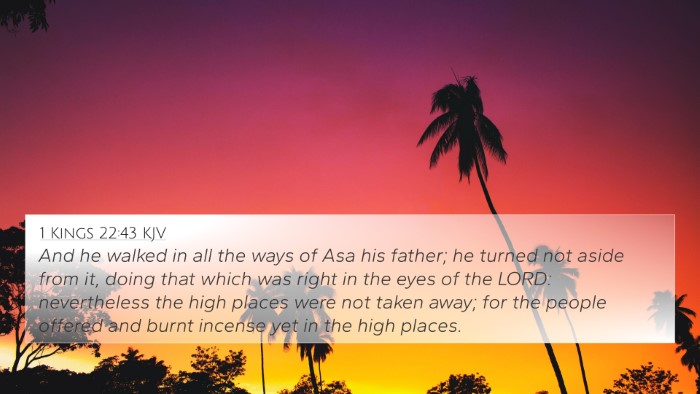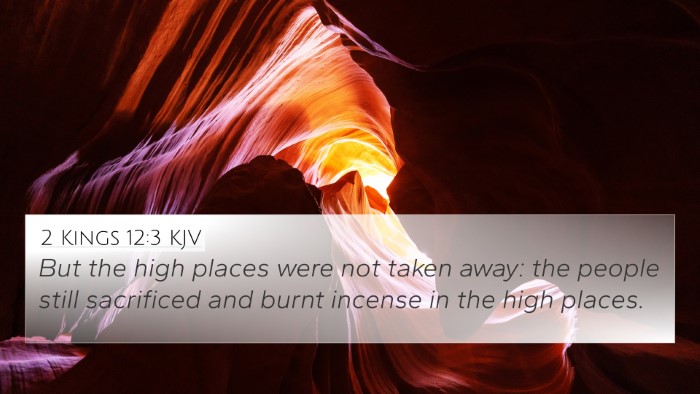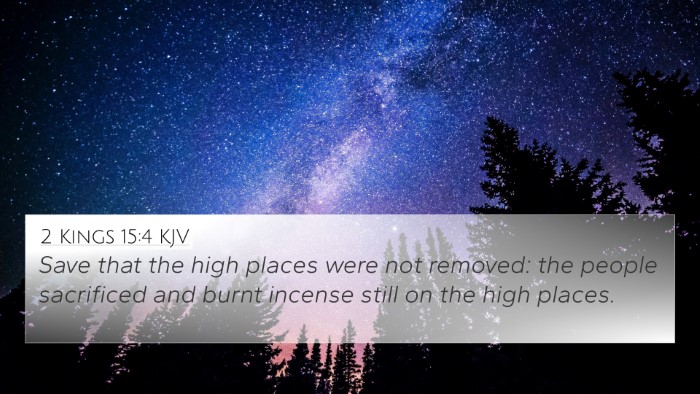Understanding 1 Kings 15:14
1 Kings 15:14 reads: "But the high places were not removed: nevertheless Asa's heart was perfect with the Lord all his days." This verse reflects the spiritual condition of King Asa of Judah and highlights the complexities of his reign, as observed by biblical commentators.
Context and Historical Background
This scripture is situated within the historical context of the divided monarchy in Israel. Asa, ascending to the throne after a series of wicked kings, implemented significant reforms, purging idol worship and reaffirming devotion to Yahweh. However, the persistence of the high places posed a challenge to the total eradication of idolatry.
Key Insights from Public Domain Commentaries
- Matthew Henry: Henry points out that Asa's heart was wholly devoted to God, illustrating that despite the physical remnants of idolatry, the essence of true worship lies within one's heart. He emphasizes the importance of internal allegiance over mere external conformity.
- Albert Barnes: Barnes reflects on the juxtaposition of Asa's personal piety against the backdrop of ongoing spiritual compromise represented by the high places. He suggests that although Asa did much good, his failure to completely eradicate these sites indicates a lingering tolerance for sin.
- Adam Clarke: Clarke interprets the notion of "perfect heart" as a commitment to God that is unwavering. He highlights that while Asa couldn’t remove all high places, his legacy of righteousness and dedication to God’s covenant was paramount.
The Significance of High Places
High places were locations where sacrifices and rituals were performed, often associated with pagan worship. Their presence in the land symbolizes a spiritual challenge that even a reform-minded king like Asa could not entirely overcome during his reign. This illustrates the struggle against entrenched idolatry that many leaders faced in Israel's history.
Theological Implications
This verse provokes questions about complete obedience to God. Asa's reign is a reminder that spiritual reforms can coexist with imperfections. The heart's sincerity, as noted in this verse, plays a crucial role in one’s standing before God.
Cross-References and Connections
The following verses provide additional context and insight into the themes reflected in 1 Kings 15:14:
- 2 Chronicles 14:2-5: This passage elaborates on Asa's reforms, indicating that he removed foreign altars and commanded Judah to seek the Lord.
- 1 Kings 12:32-33: Discusses Jeroboam's establishment of high places, showing the historical roots of idolatry in the nation.
- Deuteronomy 12:2-3: God’s command to destroy places of idol worship serves as a foundational text regarding high places.
- 1 Corinthians 3:13: A New Testament parallel that emphasizes the importance of purity and sincerity in one’s work before God.
- Matthew 5:8: "Blessed are the pure in heart," resonating with Asa’s perfect heart for the Lord.
- Jeremiah 29:13: "And you will seek Me and find Me, when you search for Me with all your heart," which reflects Asa's earnest pursuit of God.
- James 1:8: Describes a double-minded man, connecting to Asa's incomplete obedience regarding high places.
Application for Believers Today
This verse invites believers to reflect on their own commitment to God. It exemplifies how one can strive for righteousness while grappling with areas of compromise in life. The idea of a "perfect heart" suggests that true faith involves ongoing efforts toward spiritual growth and alignment with God’s will.
Conclusion
The narrative of Asa and the context surrounding 1 Kings 15:14 provides rich groundwork for understanding the connections between obedience, personal piety, and the enduring challenge of idolatry. The importance of heart posture in our relationship with God is a timeless theme echoed throughout Scripture.
SEO Considerations
For those engaging in bible cross-reference studies, exploring themes in both the Old and New Testaments using tools like a bible concordance can deepen understanding. Reflecting on Connections between Bible verses and Thematic Bible verse connections provides a broader picture of biblical narratives and teachings.














